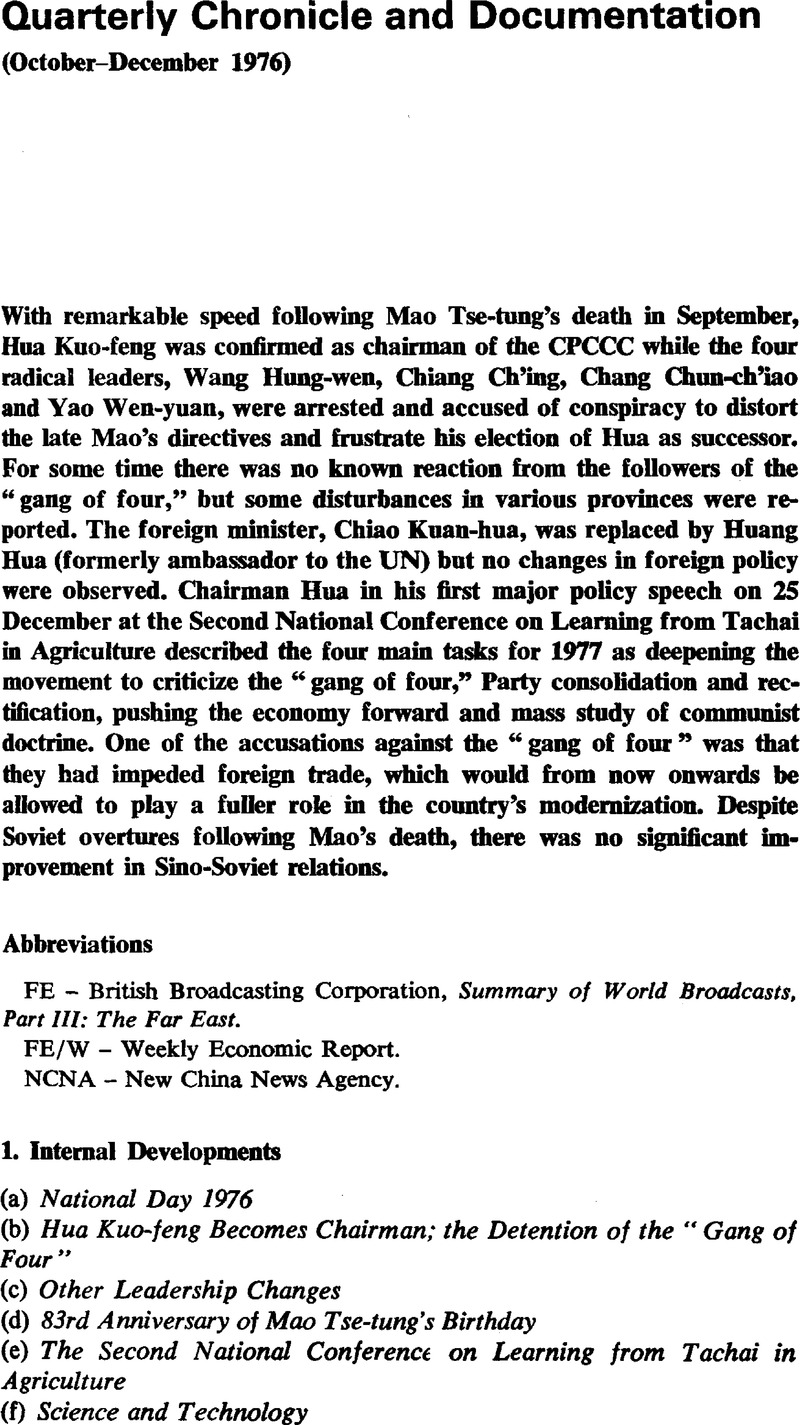Published online by Cambridge University Press: 17 February 2009

1 Peking Review, No. 1 (1 01 1977), pp. 10–25Google Scholar.
2. See “Chiang Ching and Princess Lu” in our issue [Peking Review] No. 52, 1976Google Scholar.
3. The Yenan rectification movement was a great movement launched under Chairman Mao Tse-tung's leadership in 1942. At the beginning of this movement Chairman Mao made several reports including Rectify the Party's Style of Work and Oppose Stereotyped Party Writing. In these reports, he analysed the pettybourgeois ideology and style which, masquerading as Marxism-Leninism, were prevalent in the Party, and which chiefly manifested themselves in subjectivist and sectarian tendencies, their form of expression being stereotyped Party writing. He called for a Party-wide movement of Marxist-Leninist education to rectify style of work in accordance with the ideological principles of Marxism-Leninism. The movement resulted in strengthening the unity of the whole Party on the basis of Marxism and laying the ideological foundation for the country-wide victory.
4. The five requirements Chairman Mao advanced for worthy successors to the revolutionary cause of the proletariat are as follows:
They must be genuine Marxist-Leninists and not revisionists like Khrushchov wearing the cloak of Marxism-Leninism.
They must be revolutionaries who wholeheartedly serve the overwhelming majority of the people of China and the whole world, and must not be like Khrushchov who serves both the interests of the handful of members of the privileged bourgeois stratum in his own country and those of foreign imperialism and reaction.
They must be proletarian statesmen capable of uniting and working together with the overwhelming majority. Not only must they unite with those who agree with them, they must also be good at uniting with those who disagree and even with those who formerly opposed them and have since been proved wrong in practice. But they must especially watch out for careerists and conspirators like Khrushchov and prevent such bad elements from upsurping the leadership of the Party and the state at any level.
They must be models in applying the Party's democratic centralism, must master the method of leadership based on the principle of “from the masses, to the masses,” and must cultivate a democratic style and be good at listening to the masses. They must not be despotic like Khrushchov and violate the Party's democratic centralism, make surprise attacks on comrades or act arbitrarily and dictatorially.
They must be modest and prudent and guard against arrogance and impetuosity; they must be imbued with the spirit of self-criticism and have the courage to correct mistakes and shortcomings in their work. They must never cover up their errors like Khrushchov, and claim all the credit for themselves and shift all the blame on others.
5. Chang Kuo-tao was a renegade from the Chinese revolution. Speculating on the revolution, he joined the Chinese Communist Party in his youth. In the Party he committed grave crimes. Most notoriously, in 1935 he opposed the Red Army's northward march, established his own bogus central committee, and engaged in openly traitorous activities against the Party and the Central Committee. Clinging to his reactionary stand, he rejected the Party's education and proved incorrigible. He escaped by himself from the revolutionary base area in 1938 and joined the Kuomintang secret police, thus turning himself into a shameless renegade and secret agent.
6. These are figurative descriptions of how the “gang of four” attacked and persecuted the revolutionary cadres and masses.